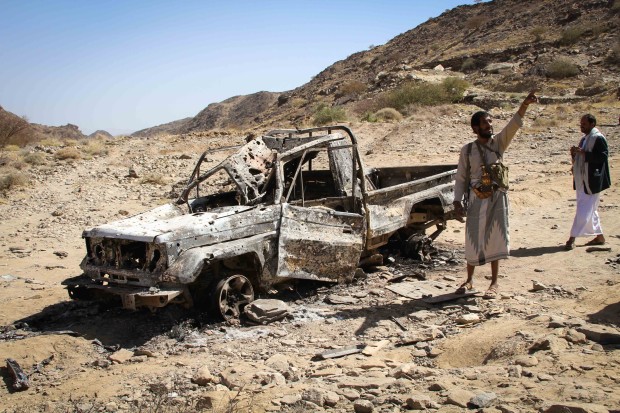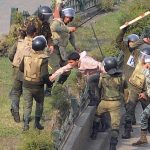by Tyler Cullis
Today Human Rights Watch (HRW) released a rather harrowing report on a US drone strike on an alleged Yemeni wedding convoy this past December:
The [December 12] strike . . . killed at least 12 men ages 20 to 65 and wounded at least 15 others, according to survivors, relatives of the dead, civil society members, and multiple media reports. The relatives said the dead included the son of the groom from his previous marriage. They said shrapnel grazed the bride under one eye, and blew her trousseau to pieces.
For advocates of the US drone program, one convenience is that areas under siege often prove inaccessible to both journalists and other civil society activists. This allows US officials to at first plausibly deny knowledge of/or participation in individual strikes and later leak to the press rosy-colored, post-hoc assessments of the strikes, without much challenge. In this way, the US public is rendered relatively immune to the human consequences of the drone program, as the victims are silenced and thus removed from the ongoing legal, ethical, and policy debates surrounding the U.S.’ targeted killing program.
Some organizations have made it a point to name the nameless. For instance, the Bureau of Investigative Journalism, which has performed important work on tracking US drones strikes and calculating its victims, started up a project in September 2013 called “Naming the Dead,” which is aimed at recording the names of drone victims. Others, like Human Rights Watch and Amnesty International, have undertaken in-depth research and reporting to both accurately assess the civilian toll of US drone strikes and question the legal underpinnings of the US’ drone program as a whole. This work has proved vital for placing pressure on the Obama administration to declare publicly the legal and policy foundations on which its program is based.
The pressure, however, has not proven altogether successful. Despite successive rounds of official statements regarding the drone program — the latest being President Obama’s May 2013 speech at the National Defense University — the White House’s legal rationale for drone strikes remains murky at best. Also, a wide chasm continues to divide the administration’s targeted killing policy (such as the promise that civilians will go unharmed) from what is actually taking place in the field from Pakistan to Yemen and Somalia. The White House has, to this day, refused to offer the legal rationale for individual strikes, as human rights groups have requested, and official post-hoc assessments of the strikes. This makes it impossible to adequately assess the administration’s compliance not only to international legal norms but also to its own “targeted killing” policies.
The initial US reaction to media reports of the drone strike now documented by HRW in Yemen was textbook. Officially, Washington denied any knowledge of or participation in the strike. Unofficially, US officials leaked to the press that all those killed in the strike were militants, targetable under the administration’s drone policy. Yemen’s government contributed to this narrative, likewise alleging that all those killed were “terrorists.” In neither case was any evidence offered to justify the characterization, but transparency was beside the point. Rather, the intended effect was to preempt allegations that civilians had been struck in the attack.
Nonetheless, protests in Rad’a, the capital of the province where the strike took place, as well as the work of Yemeni activists, pushed hard against this narrative, arguing that what was believed to be a military convoy was, in fact, nothing but a wedding procession, and that those struck were neither militants nor terrorists as US and Yemeni government officials alleged. Instead, this event was another case of a US drone strike gone terribly awry, and one that ran directly counter to US drone policy.
With its latest report, entitled, “A Wedding That Became a Funeral,” HRW confirms the basic facts of the case as they have been represented by Yemeni activists: this was indeed a wedding procession en route to the groom’s hometown for additional celebration. Whether members of Al-Qaeda in the Arabian Peninsula (AQAP) were in attendance is unclear, though as HRW astutely notes, “the burden is on the attacker” [i.e., the US] to justify the resort to lethal force and thus the lawfulness of the attack, not vice versa.
Despite US promises to undertake a review of the strike, HRW found no evidence of an ongoing internal investigation. This is particularly troubling, for as the organization notes, “the attack may have violated the laws of war . . . [and]raises serious questions as to whether US forces are complying with [US]policy requirements on targeted killings.” Following the release of the report, a Pentagon spokesperson referred reporters to statements from the Yemeni government alleging that the targets were “dangerous senior al-Qaida militants.”
The Human Rights Watch report is an important read, and one that hopefully will be widely distributed and closely parsed. So long as the pressure remains on the Obama administration to not just enunciate a restrictive targeted killing policy but to ensure internal compliance with that policy and accountability for officials who deviate from it, we are likely to see the administration take additional action to dampen public criticism. The December 12 strike in Yemen looks to be a serious case of non-compliance with both the laws of war and the US’s own drone policies, and justice for its victims will thus require strict accountability here at home.
Photo: Mousid al-Taysi near a vehicle destroyed on Dec. 12, 2013 in an alleged US drone strike. Credit: Rooj Alwazir/Al Jazeera






Drones are faceless, as are the drivers who can be anywhere in the world. Easier to kill humans with a drone, then putting humans on the ground hunting other human as in combat. Besides, not being up close and personal, leaves the pilot without a guilty conscious, at least that seems to be the case with the “O”. But then, he may be a CLOSET SOCIOPATH.